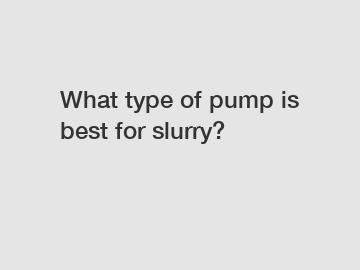What type of pump is best for slurry?
What type of pump is best for slurry?
When it comes to handling slurry, choosing the right pump is crucial. Slurry is a mixture of solid particles suspended in a liquid, often encountered in various industries such as mining, wastewater treatment, and construction. The viscosity and abrasive nature of slurry impose unique challenges on pumps, requiring specific features and capabilities to ensure efficient and reliable operation. In this article, we will explore the different types of pumps commonly used for slurry applications, discuss their advantages and limitations, and ultimately determine the best pump for slurry handling.
1. Centrifugal Pumps:

Centrifugal pumps are widely used for slurry applications due to their ability to handle high flow rates. They operate by converting rotational energy from an impeller into fluid motion, generating centrifugal force that propels the slurry through the pump. However, conventional centrifugal pumps may struggle with abrasive slurry, leading to increased wear and reduced efficiency. To address this issue, specialized centrifugal pumps, such as the slurry pump, have been developed. Slurry pumps feature enhanced wear-resistant materials and impeller designs to withstand the harsh conditions associated with slurry pumping.
2. Positive Displacement Pumps:
Positive displacement pumps work by trapping a fixed amount of slurry in a chamber and then displacing it from the inlet to the outlet. These pumps are better suited for thick, viscous slurry or applications requiring high pressure. Two common types of positive displacement pumps used for slurry are piston pumps and diaphragm pumps. Piston pumps are known for their high-pressure capabilities, making them ideal for challenging slurry conditions. Diaphragm pumps, on the other hand, provide excellent resistance to abrasion and can handle slurry with larger solid particles.
3. Peristaltic Pumps:
Peristaltic pumps, also known as hose pumps, offer a unique pumping solution for slurry applications. They use a rotating roller or shoe to compress and relax a flexible hose, creating a vacuum that draws in the slurry and then pushes it out. This design ensures gentle handling of the slurry, making peristaltic pumps suitable for shear-sensitive materials. Additionally, the hose itself acts as the only wearing part, simplifying maintenance and reducing the risk of contamination.
4. Air-Operated Double Diaphragm (AODD) Pumps:
AODD pumps utilize compressed air to alternately squeeze and release diaphragms, facilitating the movement of slurry through the pump. These pumps are highly versatile and can handle a wide range of slurry compositions, including those containing abrasive solids. AODD pumps are self-priming, meaning they can start pumping without the need for external priming. They are also equipped with a variable flow rate and can handle viscous slurry effectively.
In conclusion, various types of pumps are suitable for handling slurry, each with its own advantages and limitations. When determining the best pump for slurry applications, the specific requirements of the industry and the nature of the slurry must be carefully considered. For high-flow applications, centrifugal pumps, especially those specifically designed for slurry, prove to be highly effective. For thick and viscous slurry or high-pressure applications, positive displacement pumps, such as piston pumps and diaphragm pumps, offer reliable solutions. Peristaltic pumps are preferred when handling shear-sensitive materials, while AODD pumps excel in versatility, handling a wide range of slurry compositions. By choosing the right pump, industries can optimize efficiency, reduce maintenance costs, and ensure the smooth operation of slurry handling processes.
Want more information on Submersible Slurry Pump Manufacturer, Horizontal Slurry Pump Factory, 8/6E-HS Slurry Pump? Feel free to contact us.
116
0
0


Comments
All Comments (0)